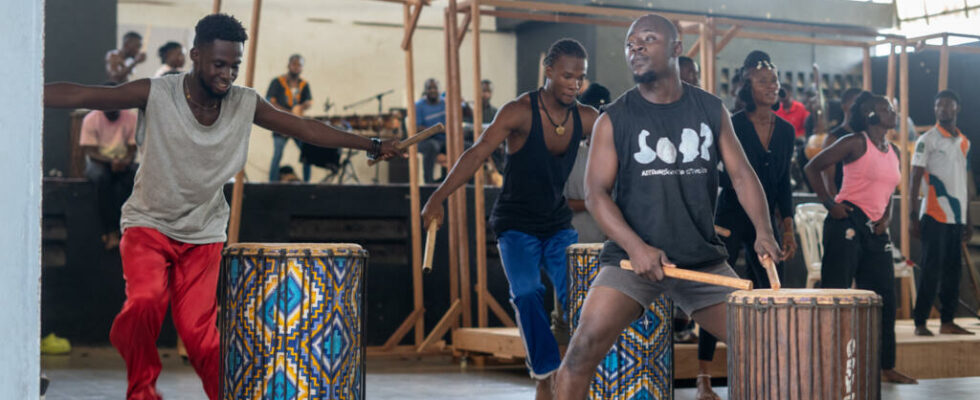It is a mythical character who takes to the stage this week in Abidjan: the 13th century conqueror-king Sundiata Keïta, founding figure in the history of the Mandingo empire in West Africa. He returns in a “Mandingo opera” produced and directed by the songwriter Abass Zein.
5 mins
From our correspondent in Abidjan,
To evoke Sounddiata Keïta, no one is better placed than the actor Cheick Oumar Tidjane Diakité, who plays the title role. “ Sundiata Keïta is the founder of the Mandingo empire. In a way, he’s my ancestor. He is a conqueror, he has the passion, he has the rage to win. For me it was a challenge. A historical character requires careful acting. When we say “Sounddiata Keïta”everyone has an image of him in their head. So how to materialize this image? When I was little, I had already watched a Malian film about Sounddiata Keïta, of which I remembered certain sequences. I really studied the character. »
Linking the world of opera and West African music
For two hours, they replay the key scenes of Sundiata Keïta’s epic, with parts played, slammed, sung and danced… The result forms what Abass Zein has chosen to call a ” Mandinka opera », a hybrid show which borrows from Western opera as much as from this traditional West African music. A perilous but controlled alchemy, hopes choir director Guy-Constant Assoukrou. “ We are really going to get into the style of the Mandinka region. The small nuance is that the choir will sing in this style, but with rather lyrical voices. Like it goes: “The great day has arrived, when Maghann’s son is born! There he is the Lion of Mandé! Welcome Mari Djata!” Meanwhile, there are percussions playing, the kora, the balafon… »
All the music, except one taken from the griot repertoire, is original music composed by Fred Mankayé… Who must have succeeded in the feat of “ bringing together two different worlds “. On a technical level, the “ tones » Western classical music and Mandinka music are different, as are the “ temperaments “. “ The tuning of the instruments does not correspond to the quality of Western instruments found on the market.he explains. You have to go to the land, take authentic instruments and listen to them, to restore the soul of these instruments. The spirit of Western music is not at all the same as the spirit of Mandinka music, the treatment of themes is different… » By working on instrumentation, composition, orchestration and arrangements, Fred Mankayé and his musicians strived to “ mix these two worlds, while offering a current and entertaining show “.
Also readScreening in Bamako of the film “African Glory” about the transatlantic expedition of a Mandingo emperor
“ Africa is not the cradle of the world, it is the brain of the world »
In addition to the fifteen musicians, the opera has around fifteen actors and around thirty dancers, not counting the choir. In all, around a hundred artists will be present on stage. A ” very large production “, rejoices Abass Zein, who promises a show “ grandiose »… and for him, a childhood dream come true. “ It’s always made me dream, ever since I was a kid. This cripple who becomes king… It’s a real tale, a real legend, a real Walt Disney story. And then later, I became interested in revisiting African history in my shows. And I realized how much Africa had contributed to the history of humanity, and which we ignore, or pretend to ignore. I often like to say that Africa is not the cradle of the world, it is the brain of the world. And I said to myself: we have to make a show of it. »
To meet demand, Abass Zein had to organize three performances at the French Institute, which took place on December 12, 13 and 14, all sold out, for a total of 1,800 spectators. After these three dates, Abass Zein hopes to offer performances to the general public in schools and universities.
“ A seminal, mythical figure in the history of Mandé »
Because the figure of Sundiata Keïta is already known, and popular, among Ivorians… Since his epic is taught in Côte d’Ivoire from primary school. Although it left very few archaeological traces, its history was transmitted by griots, such as Kela Balla Diabaté and Wa Kamissoko, on the basis of oral traditions. And has lost nothing, today, of its symbolic force, explains history professor Chikouna Cissé, lecturer at Félix Houphouët-Boigny University, specialist in migrations and Mandingo civilizations. “ Sundiata remains a seminal, mythical figure in the history of Mandé. It’s clear that there are a lot of exaggerations in the story about him. But the historical figure existed. He is best known for his victory over Soumaoro Kanté in 1235, a gesture recounted by historians and men of letters. » After its first transcription written in 1960 by Djibril Tamsir Niane, Sundiata or the Mandinka epicbased on the story of the griot Mamadou Kouyaté, Mansan Makan Diakité, Drissa Diakité, Laurent Gbagbo, etc. were also interested in it.
“ It is a transverse figurecontinues Chikouna Cissé. At independence, the leaders of this period needed to crystallize a historical consciousness around mythical figures. Men always need ancestors when the present hurts. When we have been colonized, we always need to respond to colonization with new imaginations that restore us to a glorious past, a past that allows us to nourish the fabric of rebirth. This is why Sundiata, and not only him, many figures from previous centuries, are taught to give new generations something to nourish founding, revolutionary utopias. »
Also readThe “African Empires” series explores African history before colonization
